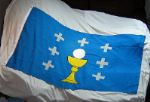Timeline
of the Holy Grail of Galicia
13th
Century |
Earliest
representations
The Holy Grail appears as the arms of the kings of Galicia in the
Segar's Roll, an armorial compiled in England circa 1282. This
early representation features the arms of the kings of Galyce
as three golden Grails over an azure field, set in a similar manner
as to the later arms of the kings of Sweden.

Galice - Hérault Vermandois |
Soon after, in
the Armorial du Hérault Vermandois compiled in France
between 1285 and 1300, the Holy Grail of Galicia is depicted as a
single golden chalice over a blue field with the following description:
"Le Roy de Galice, dasur a ung galice dor couvert en magniere
dune couppe Azure a covered cup or".
|
15th
Century |
The golden chalice
over a blue field became the standard representation of the Holy Grail
of Galicia during the 15th century. As such, it appears under the
name Galiscién in a very comprehensive armorial made
in Sweden in 1436 called Codex Bergshammar, and also in the
Armorial Gymnich from Flanders, compiled circa 1445. Written
towards the end of the 15th century, the Holy Grail appears again
in a manuscript description of the Kingdom of Galicia found in the
library of the castilian monastery of 'El Escorial'.
|
16th
Century |
The
crosses are added on the blue field
The new artistic fashions of the 16th century brought some baroque
decoration into the field of the flag such as crosses and angels.
In Galicia there still remains several Royal Grails carved on public
buildings from the 15th and 16th centuries: the Royal Hospital of
Santiago (also know as the Hostal Reyes Católicos),
St Miguel's Gate in the ramparts of Corunna, Betanzos city hall, the
Old Tower and the Vestry of the Cathedral of Lugo, the church tower
of Noia, the manor house of the Moscoso caln in Laxe, etc...
The Holy Grail
as the arms of the Kingdom of Galicia appear as well during the 16th
in the Arch of Triumph of European emperor Maximilian I von Habsburg,
made in 1515 by the famous German painter Albrecht Dürer. The
arms and flag of the Kingdom of Galicia are also depicted in a beautiful
canvas painted in 1559 to commemorate the funeral of European emperor
Charles V. The painting shows a knight holding the flag of Galicia
as a golden Holy Grail surrounded by crosses over a blue field. The
arms of Galicia were painted in a similar way in a heraldry book written
around 1581 in Lyon, France.
|
17th
Century |
Six
crosses become the standard decoration
The golden Holy Grail surrounded by six crosses, three on each side
of the chalice, became the standard representation of the Arms of
Galicia during the 17th century.
The Holy Grail
of Galicia was painted this way on the map "Gallaecia Regnum"
(Kingdom of Galicia) made in 1598 by Galician monk Fernando Ojea,
and in a similar map made some years later by Flemish cartographer
Abraham Ortelius. The Grail surrounded by six crosses appeared also
in an engraving of the coat of arms of the kingdoms of Spain made
in 1663 by French geographer Nolin.
It seems however this may have been a slow standardising process as
there are also other examples where artists decided to paint the Holy
Grail of Galicia following previous standards used in the 16th or
15th century, for example Italian cartographer Giacomo Cantelli in
his 1696 map Regno di Galicia.
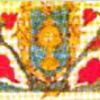
Arms of Galicia in a Royal Letter, 1552
[Enlarge image] |
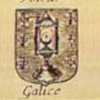
Galice, in Armes des Royaumes d'Espagne, Nolin,
1663
[Enlarge image] |

Regno di Galicia, by Giacomo Cantelli, map from 1696
[Enlarge image] |

Holy Grail of Galicia in coat of Arms of Asturias, by G. Cantelli,
1696
[Enlarge image] |
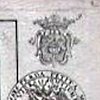
Holy Grail on the map SudWest Custe von Gallicien, Gabriel
Bodenehr, 1715
[Enlarge image] |
The
7th cross over the Grail
While the 6 crosses (three on each side of the chalice) became the
standard Galician flag for almost two centuries, a 7th cross emerged
eventually on top of the Grail. That 7th cross came from the top of
the chalice, whose lid was ending in the shape of a cross, and joined
independently the rest of the crosses over the field of the flag.
Some contemporary authors have speculated whether the number of 7
crosses used to accompany the Holy Grail might have been chosen to
symbolise the seven major cities of the Kingdom of Galicia. Such a
theory is unfounded and lacks historical rigor. The crosses were just
born to decorate the empty space around the Grail and evolved in a
random number since the 16th century.
|
18th
Century |
Military
Flag: the Holy Grail over a red field
In 1571 the Kingdom of Galicia sent a fleet to fight in the Battle
of Lepanto against the Turks. The Galician Navy flew her own flag,
which consisted of the Holy Grail surrounded by one angel on each
side, over a red field. Almost two centuries later we find again the
Grail over a red field in a military context as the Arms of the
Regiment Galicia. This Galician regiment can be traced back to
the Lombardy Troops in 1534,  and
has fought in wars in Scotland (allied with the Jacobites), Savoy,
Piedmont, Argentina, Spain and France. The current flag of Mondoñedo,
which also displays a golden Grail over a red field, is heir to a
similar Galician military flag carried by the Mondoñedo Provincial
Regiment during the 18th century. and
has fought in wars in Scotland (allied with the Jacobites), Savoy,
Piedmont, Argentina, Spain and France. The current flag of Mondoñedo,
which also displays a golden Grail over a red field, is heir to a
similar Galician military flag carried by the Mondoñedo Provincial
Regiment during the 18th century.
Naval
Flag: the Holy Grail over a white field
A new variation of the traditional blue flag of Galicia started to
be used for Naval purposes during the 18th century, as described in
the Encyclopédie de Diderot et d'Alembert: "Pavillon
de la province de Galice: il est blanc, chargé au milieu d'un
calice ou coupe couverte d'or, accompagné de six croix rouges,
trois de chaque côté", which is: a golden Holy
Grail surrounded by three red crosses on each side, over a white field.
The same
white flag appeared
again in a naval context, flown by a USA frigate at the end of the
18th century.
The apparently widespread use of the white flag during the 18th century
provoked confusion among several 19th century writers who adopted
the white naval flag as the National Galician flag, ignoring that
the historical flag of the Kingdom of Galicia had actually a blue
field, not white.
|
19th
Century |
The Holy Grail, substituted by the Corunna Saltire
The 19th century was a period of yet even more political and economic
decadence for the Kingdom of Galicia. Much as with Ireland, almost
half of the Galician population left to the Americas fleeing from
poverty. The Galician cultural renaissance of the 19th century was
mainly supported and financed by the Galician exiles. During this
century Galicians in the New World adopted the Corunna Saltire as
the modern national
flag of Galicia. From here onwards, the Holy Grail of Galicia
would not be used as a flag, but strictly as a Coat of Arms.
|
20th
Century |
The
Grail flies again on the flag
Early in the 20th century, the Archivist of the Royal Academy of Galicia,
Mr. Cesar Vaamonde, felt the need to remind Galician intellectuals
that "The traditional colours of the Arms of Galicia are golden
chalice and blue field. There are however some authors who are still
depicting the national arms in a different manner". In the
same article, published in the Bulletin of the Academy, he also complained
that the historical flag of Galicia "is currently being substituted
by the Saltire of Corunna".
Historical studies in Galicia were at that time just beginning and
confusion about the history of the Galician arms was widespread. The
situation was highlighted in 1937 by the leader of the Galician National
Party, Mr Afonso Castelao, who wrote: "I remember people discussing
about how the historical Galician flag looked like, and nobody being
able to be completely sure about her true colours. Only few of us
knew that our historical national flag was not the white flag".
Some members of the Galician National Party tried to bring the Grail
back into the spotlight as the genuine national symbol of Galicia,
yet the Saltire of Corunna had become too widespread in the Galician
society. Moreover, Franco's coup d'état and his subsequent
dictatorship halted for half a century the Galician cultural revival.
 After
the Franco dictatorship, the Royal Academy of Galicia standardised
the desing of the Holy Grail of Galicia and asked the Galician Government
to officialise the historical arms of the nation. The Galician Government
decided to merge the modern national flag and the historical arms
of Galicia into what is called the 'Galician
State Flag'. After
the Franco dictatorship, the Royal Academy of Galicia standardised
the desing of the Holy Grail of Galicia and asked the Galician Government
to officialise the historical arms of the nation. The Galician Government
decided to merge the modern national flag and the historical arms
of Galicia into what is called the 'Galician
State Flag'.
 Galician National Flag
Galician National Flag |
 Historical arms of Galicia
Historical arms of Galicia |
 Galician State Flag
Galician State Flag |
|
The State Flag, which features the Holy Grail of Galicia over the
modern national flag, is the the official flag that must be flown
in all institutional events by the national and local governments
in Galicia, according to the Law 5/1984 of National Symbols of Galicia.
"The National Flag of Galicia shall display the official
Coat of Arms when flown on public buildings and institutional events
in Galicia"
Law 5/1984 of Symbols of Galicia, Article 2.2.

*
* * * *
The Holy Grail has been the national symbol of the Kingdom of Galicia
for almost a millennium. As part of this initiative for the historical
banners and flags of Galicia, you can now have your flag of the
Kingdom of Galicia featuring the Holy Grail and crosses as standardised
by the Royal Academy of Galicia.
*
* * * *
|
|
 The
Holy Grail: National Symbol of Galicia for a Millennium
The
Holy Grail: National Symbol of Galicia for a Millennium
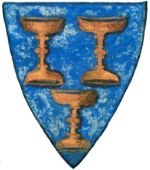


















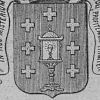
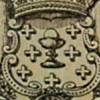
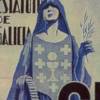
 Galician National Flag
Galician National Flag Galician State Flag
Galician State Flag
